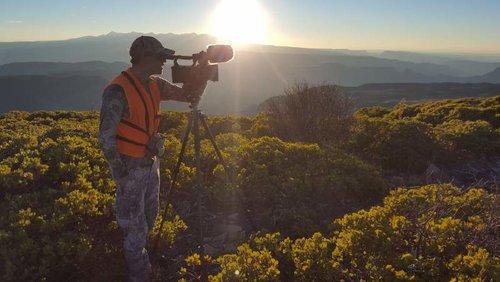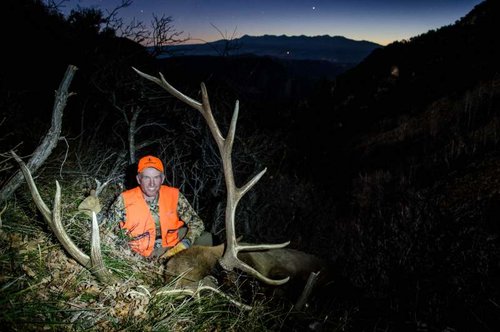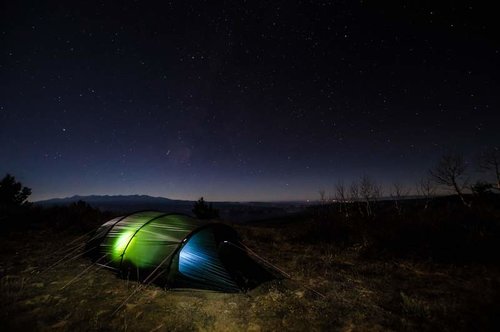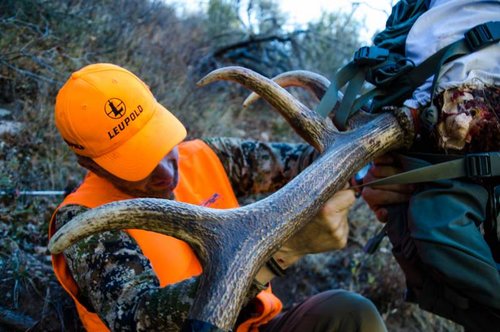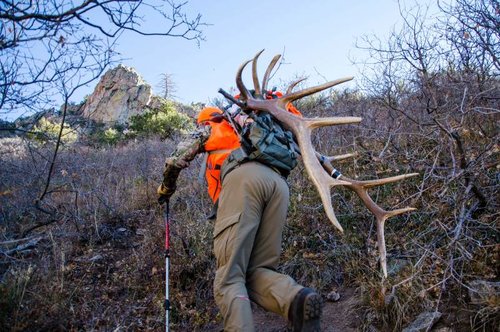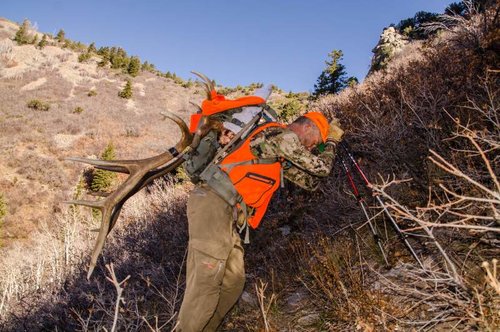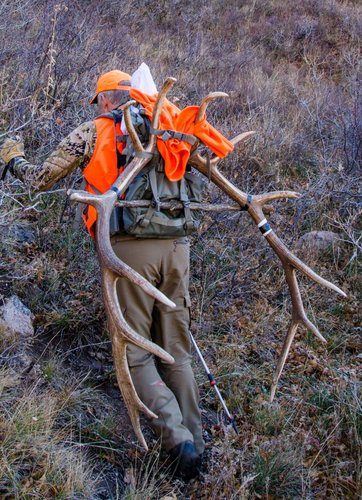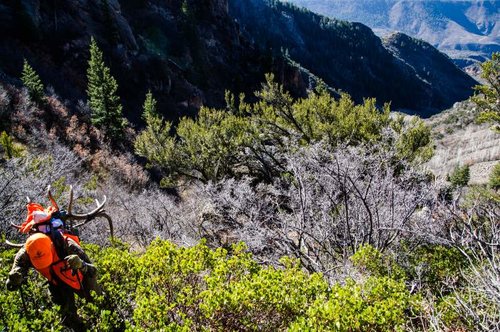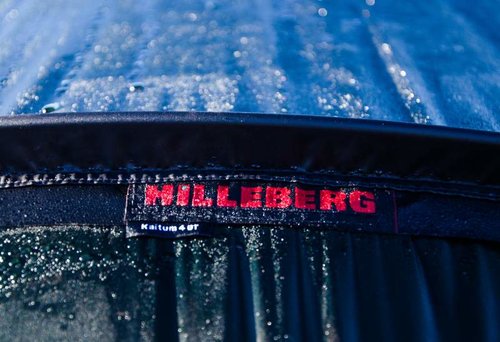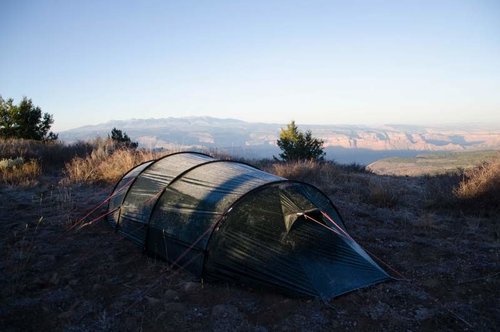Since I have a small opening this afternoon, I will try to cram in the details of this short Colorado elk hunt. You've seen pics in the Nosler Ammo thread, but thought I would provide more details here.
Most know this was a Unit 61 3rd Rifle Season tag that took me 19 points to draw. I was praying for snow, or at least a bit of cooler weather, as that is very helpful in glassing bulls in these canyons. With temps over 70F, my prayers were obviously unanswered. The forecast for the entire hunt was warm temps. I thought about all the 3rd Season deer tag holders who had burned tons of points due to the later dates this season, only to be basking in T-shirt weather.
We drove from the NV deer hunt to SLC where we dropped Matthew off for his flight back to NC. From there, Marcus and I drove to the Plateau, getting camp set up in late afternoon of the second day of season, allowing enough time to drive the Yamaha Viking to the top of the mesa for twenty minutes of glassing (note, on these roads, a side-by-side is far faster than a pick up). Marcus got glimpse of a group of eight bulls in the bottom of a canyon. That was all for the evening, but a good comfort to know at least one spot on my map held elk.
The next morning was to retrace our steps up the mesa, parking the SxS well before daylight and being at our glassing spot to wait for the sun to rise. I was told about this little knob by a former tagholder. He told me that it didn't look like much, but it got you high enough above the P-J that you could glass a lot of country. He was right. It was well worth the hike to get here.
As the sun rose behind us it illuminated many orange dots a couple miles across the canyons. Closer examination with the 80mm Gold Ring showed them all to be bulls, with the exception of four cows milling across a couple hundred yards below us. Having six days to hunt, I was mostly interested in window shopping. After all, I had waited a pretty long time to pull this tag.
Within an hour we had seen a black bear, a half-decent mule deer buck, and three groups of elk that had a total of 14 bulls, three of which were worth a closer look. By the time the sun had been up an hour, the elk had crawled down into or around the dark shaded corners of canyons and hillsides. If we had arrived at this glassing spot an hour after sunrise, we would have been convinced that no elk existed.
I often say that late season public land elk is a glassing game, even in hot weather like this. They just don't stand around very long. I need to look up one of the old studies I read, but it said something to the affect that a bull elk in his full winter coat will spend more energy thermo-regulating his body temp when it is 40F than when it is -20F. Given how fast they ran from the sun, this day appeared to support that study.
With the elk gone, I pulled out the maps and started looking at the Forest Travel Plan; What roads would get closest, and if there was any way to negotiate the big canyons near which these bulls were hanging out? The Travel Map showed why the bulls were here - all the trails were closed to motorized travel, with only a few stem roads getting you into the heart of this area. I knew that in advance and such is why all my "sanctuary" dots on my map were located within the areas with closed trails.
It was determined that rather than waste the afternoon resting at camp, we would go exploring and find the best possible way to get close to those sanctuary areas. We made good time getting there, even being interrupted by a few hunters who wanted to visit. Once there, I was once again reminded of how looking at terrain from afar has a tendency to flatten it out. This was NOT flat terrain. In fact, I had to drop a couple hundred feet off the lip just to look down into an area a smaller group of bulls had disappeared. Thankfully, none of those had interested me much.
Marcus and I smiled at the task ahead. There was a bit of coverage at times, so I rechecked the weather forecast. Marcus knew the result based on my moaning about the years of points to draw, only to be disrupted by Arizona-style weather. Oh well, can't change it, so better figure out how to kill a bull in it.
Looking at the GPS and the onXmap, I could see the least steep, though still very steep, nose of the mesa dropping down 600' vertical to what was supposedly an old trail. From there, we could traverse a side of this mesa for a mile, hit a saddle, then scale up the other side to the opposing mesa where two of the bigger bulls had taken their beds. As with all things, the view from atop seems better than it really.
Let me say this right now; How you guys in CO and UT hunt in that oak brush and don't give up in complete frustration, is a small miracle. Even on the way down, I was cussing and fighting with the oak to return the items it was stealing from my body and off my pack. It is reminiscent of the devil's club jungles in Alaska, without the rain and slippery moss. If I never see another oak in my life, it will not hurt my feelings.
Most know this was a Unit 61 3rd Rifle Season tag that took me 19 points to draw. I was praying for snow, or at least a bit of cooler weather, as that is very helpful in glassing bulls in these canyons. With temps over 70F, my prayers were obviously unanswered. The forecast for the entire hunt was warm temps. I thought about all the 3rd Season deer tag holders who had burned tons of points due to the later dates this season, only to be basking in T-shirt weather.
We drove from the NV deer hunt to SLC where we dropped Matthew off for his flight back to NC. From there, Marcus and I drove to the Plateau, getting camp set up in late afternoon of the second day of season, allowing enough time to drive the Yamaha Viking to the top of the mesa for twenty minutes of glassing (note, on these roads, a side-by-side is far faster than a pick up). Marcus got glimpse of a group of eight bulls in the bottom of a canyon. That was all for the evening, but a good comfort to know at least one spot on my map held elk.
The next morning was to retrace our steps up the mesa, parking the SxS well before daylight and being at our glassing spot to wait for the sun to rise. I was told about this little knob by a former tagholder. He told me that it didn't look like much, but it got you high enough above the P-J that you could glass a lot of country. He was right. It was well worth the hike to get here.
As the sun rose behind us it illuminated many orange dots a couple miles across the canyons. Closer examination with the 80mm Gold Ring showed them all to be bulls, with the exception of four cows milling across a couple hundred yards below us. Having six days to hunt, I was mostly interested in window shopping. After all, I had waited a pretty long time to pull this tag.
Within an hour we had seen a black bear, a half-decent mule deer buck, and three groups of elk that had a total of 14 bulls, three of which were worth a closer look. By the time the sun had been up an hour, the elk had crawled down into or around the dark shaded corners of canyons and hillsides. If we had arrived at this glassing spot an hour after sunrise, we would have been convinced that no elk existed.
I often say that late season public land elk is a glassing game, even in hot weather like this. They just don't stand around very long. I need to look up one of the old studies I read, but it said something to the affect that a bull elk in his full winter coat will spend more energy thermo-regulating his body temp when it is 40F than when it is -20F. Given how fast they ran from the sun, this day appeared to support that study.
With the elk gone, I pulled out the maps and started looking at the Forest Travel Plan; What roads would get closest, and if there was any way to negotiate the big canyons near which these bulls were hanging out? The Travel Map showed why the bulls were here - all the trails were closed to motorized travel, with only a few stem roads getting you into the heart of this area. I knew that in advance and such is why all my "sanctuary" dots on my map were located within the areas with closed trails.
It was determined that rather than waste the afternoon resting at camp, we would go exploring and find the best possible way to get close to those sanctuary areas. We made good time getting there, even being interrupted by a few hunters who wanted to visit. Once there, I was once again reminded of how looking at terrain from afar has a tendency to flatten it out. This was NOT flat terrain. In fact, I had to drop a couple hundred feet off the lip just to look down into an area a smaller group of bulls had disappeared. Thankfully, none of those had interested me much.
Marcus and I smiled at the task ahead. There was a bit of coverage at times, so I rechecked the weather forecast. Marcus knew the result based on my moaning about the years of points to draw, only to be disrupted by Arizona-style weather. Oh well, can't change it, so better figure out how to kill a bull in it.
Looking at the GPS and the onXmap, I could see the least steep, though still very steep, nose of the mesa dropping down 600' vertical to what was supposedly an old trail. From there, we could traverse a side of this mesa for a mile, hit a saddle, then scale up the other side to the opposing mesa where two of the bigger bulls had taken their beds. As with all things, the view from atop seems better than it really.
Let me say this right now; How you guys in CO and UT hunt in that oak brush and don't give up in complete frustration, is a small miracle. Even on the way down, I was cussing and fighting with the oak to return the items it was stealing from my body and off my pack. It is reminiscent of the devil's club jungles in Alaska, without the rain and slippery moss. If I never see another oak in my life, it will not hurt my feelings.




